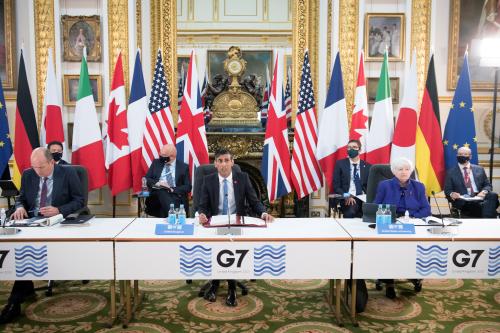President Obama started his second term in office with a clarion call to act on climate change in his inaugural address. The energy and climate related provisions of the State of the Union address, reiterated yesterday by Heather Zichal, his deputy assistant secretary at an event here in Washington, have provided the first signs of how his vision will survive contact with reality. In her remarks, Ms. Zichal noted that the Administration’s policy has been “fluid” as it responds to a rapidly changing domestic energy sector while making meaningful progress on addressing the challenge of climate change.
Amid the flux, the blueprint for the president’s second term agenda suggest an Administration that is willing both to double down on its first-term lower-carbon agenda and to explore new ways to put the country on a path to greater energy security. The goals to double the amount renewable energy in the U.S. by 2020 show an Administration building on its commendable record of green-energy development and unbowed by Republican grandstanding over a small number of failed government-support projects. The drive to greater efficiency through a “race to the top” program is also laudable and continues the very good progress the Administration made in its first term. The biggest energy-related innovation of the president’s blueprint is a call for an Energy Security Trust fund, to be financed by taxes on oil and gas production on Federal lands, and to be used to invest in technologies to wean the U.S. transportation fleet off gasoline. This proposal shows consistency on the part of a president whose first term plans for electric cars are looking like they will fall far short of expectations. It also, intriguingly, suggests some expanded federal support for natural-gas vehicles.
However, while all of the initiatives unveiled so far by Obama 2.0 have merit from an environmental perspective, they do more to bolster longer-term U.S. energy security and to reduce domestic carbon emissions than they do to address the real global climate threat that the president outlined in his inaugural address. The president is right to see expanded U.S. oil and gas production as a potential means of raising revenue for the development of low-carbon technologies. However, the Energy Security Trust proposal, which will probably require an act of Congress to be implemented, fixes only part of the problem. While U.S. vehicle-related emissions are substantial, reducing them – even to zero – is not going to address global climate change. The political economy of the Trust is also questionable: by designing the Trust as a tax on oil production that is specifically destined to back out gasoline for the U.S. vehicle fleet, the initiative essentially asks oil producers to pay to diminish their largest market.
To really address the global climate challenge, the president should first acknowledge three incontrovertible facts. He should then build on the Trust idea to strike a larger bargain that will get industry support and will make a meaningful impact on carbon emissions worldwide.
Start with the facts.
The first is that global energy demand will continue to grow over the next two decades. Nearly all of this demand growth will be in the countries of the non-OECD, particularly India and China. Under any circumstances, the majority of this demand will be met using fossil fuels such as coal, oil and gas. The second trend is that the current efforts to mitigate climate change are not working. Despite some incremental progress through the annual meetings under the aegis of the United Nations, the international community is on track to singularly fail to meet its goal of limiting global warming to two degrees Celsius, the point at which many scientists see catastrophic climate change becoming irreversible. The third trend is that the United States is undergoing a resurgence as a producer of hydrocarbons. Hydraulic fracturing, directional drilling, and seismic mapping technologies have enabled untold quantities of previously uneconomic “unconventional” oil and gas to be produced from the U.S. mainland. The boom in shale gas and tight oil production has been accompanied by hyperbolic predictions of U.S. energy independence, a wealth of new high-paying employment opportunities and a resurgence of U.S. manufacturing, and has relegated discussions on the environment to a footnote in the national discussion around energy.
Against a backdrop of expanding global hydrocarbon usage, stalled multilateral efforts on greenhouse gas mitigation, and a newly resurgent and politically potent oil and gas industry at home, how can the president possibly hope to make any meaningful impact on climate change? What about this: By striking a grand bargain with industry and hydrocarbon-producing states that allows full-scale development and exportation of U.S. hydrocarbon resources in exchange for a production-based carbon tax, the Obama Administration could enhance U.S. economic and political interests while investing the two technologies that will be critical in any attempt to address climate change. Here’s how it works.
First, accept that the near-term forces of global supply and demand are irresistible, and seek to take advantage of them. As China, India, and other emerging economies continue their growth, they will continue to expend increasing amounts of money on energy imports. Currently, this money goes principally to the OPEC nations, Russia, Australia, Kazakhstan and a handful of other resource-rich countries. Given its vast reserves of coal, oil and gas, the United States could position itself as a – perhaps the – major beneficiary of global demand, putting valuable foreign exchange in its coffers and strengthening its geopolitical position by becoming a stable supplier to key allies. Such a policy would involve the increased leasing of acreage on federal lands for oil and gas exploration; permitting of ancillary pipeline infrastructure projects and railway and port projects; and the enabling of crude oil and gas exports, which are currently subject to policy restrictions or prohibitions.
In exchange for these measures, the Administration should implement a modest but meaningful carbon-based tax on fossil-fuel production, with a clear schedule for incremental increase. The introduction of a carbon tax would serve a two-fold purpose. It would demonstrate to the international community that the United States takes climate change seriously and is willing to introduce measures to address it; such an overture would increase Washington’s credibility in discussions around emissions reductions and would serve to encourage other large emitters to follow suit. It would also generate revenue, which should be allocated to technologies that have the best chance of addressing emissions on a global scale: carbon capture and storage (CCS) and advanced battery technologies. While policy tools like renewable portfolio standards and production tax credits have added to the stock of non-fossil energy sources, they will have a negligible impact on climate change as long as coal – soon to overtake oil as the world’s leading energy source – continues to be burned in the developing world. Only by reducing the carbon emissions of coal (and, eventually, gas) in the global power sector or finding scalable alternatives for base-load power will we have any chance of stabilizing greenhouse gas emissions in time. Both CCS and large scale batteries, which enable the greater deployment of intermittent renewable energy sources like wind and solar to be used as base-load power, meet this challenge. The development of batteries for transportation will address the next biggest carbon-emitting sector. The funds should be allocated via an independently run green bank, whose objective would be to stimulate and leverage private sector investment. Having proven cost-effective CCS and advanced batteries at scale, U.S. companies would then be in a position to become the leader in the supply of these essential technologies to the rest of the world.
The president’s inaugural address laid out the scale of the problem and his promise to “respond to the threat of climate change” was a welcome reengagement in one of the signature challenges of our time. Some of the new ideas from the White House show that the second Obama Administration is serious about improving U.S. energy security and shows some creative thinking on supporting a lower-carbon trajectory. The president should build on the latter to address the former: only by thinking big and taking an international leadership role will the U.S. make any meaningful difference to climate change.
The Brookings Institution is committed to quality, independence, and impact.
We are supported by a diverse array of funders. In line with our values and policies, each Brookings publication represents the sole views of its author(s).



Commentary
Fluid and Gases: How Obama Can Balance Energy and Environmental Priorities
February 28, 2013